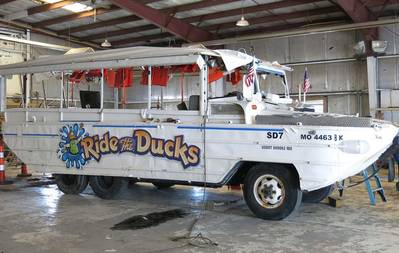US Coast Guard Calls for Comments on Duck Boat Rule
The US Coast Guard has issued an interim final rule on mandated requirements for DUKW amphibious passenger vessels and requested comments.
The statutory mandate was enacted after the sinking of the Stretch Duck 7 on July 19, 2018, which resulted in the loss of 17 lives on Table Rock Lake, Missouri.
More than seven hours prior to the accident, the National Weather Service had issued a severe thunderstorm watch for the area, followed by a severe thunderstorm warning a minute before the vessel departed the passenger boarding facility. The National Transportation Safety Board (NTSB) accident investigation identified safety issues related to: company oversight, engine compartment ventilation closures, reserve buoyancy, survivability, and Coast Guard oversight.
Contributing to the sinking was the Coast Guard’s failure to require sufficient reserve buoyancy in amphibious vessels. Contributing to the loss of life was the Coast Guard’s ineffective action to address emergency egress on amphibious passenger vessels with fixed canopies, such as the Stretch Duck 7, which impeded passenger escape.
Section 11502 of the James M. Inhofe National Defense Authorization Act (NDAA) for Fiscal Year 2023 mandates additional safety measures for DUKW amphibious passenger vessels operating on navigable waters subject to Coast Guard jurisdiction. This interim final rule codifies the statutorily mandated requirements.
Specifically, the 2023 NDAA directs the Coast Guard to require that operators of DUKW APVs comply with nine requirements within 180 days and defines a DUKW APV as a vessel that uses, modifies, or is derived from the General Motors Corporation (GMC) DUKW–353 design, and operates as a small passenger vessel in “waters subject to the jurisdiction of the United States,” as defined 33 CFR 2.38 (or a successor regulation). The nine requirements are:
(1) Remove the canopies and any window coverings of such vessels for waterborne operations, or install a canopy that does not restrict horizontal or vertical escape by passengers in the event of flooding or sinking;
(2) If a canopy and window coverings are removed from any such vessel pursuant to paragraph (1), require that all passengers wear a personal flotation device approved by the Coast Guard before the onset of waterborne operations of such vessel;
(3) Reengineer such vessels to permanently close all unnecessary access plugs and reduce all through-hull penetrations to the minimum number and size necessary for operation;
(4) Install independently powered electric bilge pumps that can dewater such vessels at the volume of the largest remaining penetration in order to supplement an operable Higgins pump or a dewatering pump of equivalent or greater capacity;
(5) Install in such vessels not fewer than four independently powered bilge alarms;
(6) Conduct an in-water inspection of any such vessel after each time a through-hull penetration has been removed or uncovered;
(7) Verify the watertight integrity of any such vessel through an in-water inspection at the outset of each waterborne departure;
(8) Install underwater light emitting diode (LED) lights that activate automatically in an emergency; and
(9) Otherwise comply with any other provisions of relevant Coast Guard guidance or instructions in the inspection, configuration, and operation of such vessels.

















